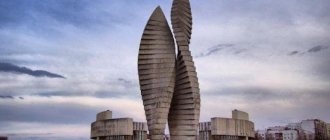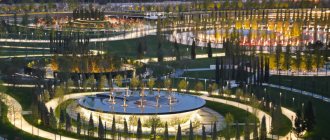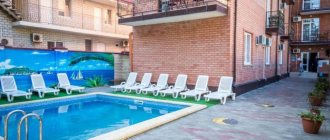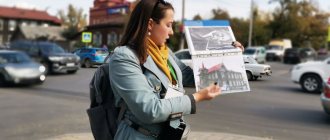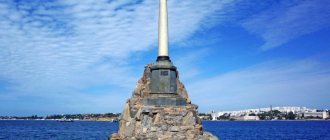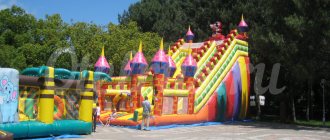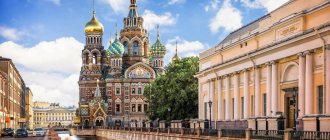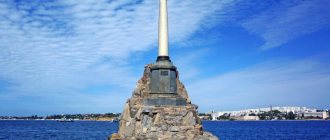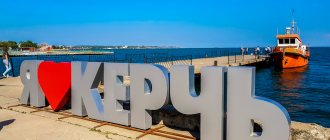Krasnodar region is one of the most beautiful and multifaceted regions of Russia. First of all, it is famous for its excellent sea and ski resorts. Holidays on the Black Sea coast, which since Soviet times have been the cherished dream of most residents of the USSR, do not lose popularity today.
There are many natural attractions here: in addition to the sea and beaches, guests will find nature reserves with rare plants and animals, wild rivers, stunning mountain panoramas, picturesque lakes and waterfalls. Fans of active recreation can go diving or conquer the snow-covered slopes of the Krasnaya Polyana ski resorts, go on a jeep tour or engage in water sports. The Krasnodar region has many man-made monuments, interesting museums and ancient buildings, because this area has been inhabited since prehistoric times.
Traffic jams are real at any time of the day
Narrow streets . I was shocked when I realized that 70% of the roads in Krasnodar are single-lane. And this is not good. This applies to both the center and new buildings and roads in new residential complexes. One lane going there, the other in the opposite direction. And on the road there is immediate collapse if an accident occurs, someone boils over or stalls. There are so many traffic jams because of this. And at any time of the day. I thought it was only in the morning and evening, but no. During the day on weekdays, everything is also worth it. And the disadvantage of single-lane roads is that you can’t go around someone who is standing with a left turn signal and allows oncoming traffic to pass. And so the traffic jam behind this accumulates.
25 main cities of the Krasnodar region (1 photo)
Krasnodar
The largest cultural and economic center in the region.
Its location 100 km from the sea had little effect on its tourist attractiveness. The city is “sick” of football: Krasnodar took over the baton from the Kuban club. Its stadium is one of the best in Russia. The adjacent huge park is modern and will give a head start to European ones. Krasnodar is located on the “life line” - exactly between the equator and the North Pole. Population – 932,629 people (2020).
Sochi
The main resort of Russia on the Black Sea. Remains popular since Soviet times. The hosting of the Olympics here in 2014 gave impetus to a new wave of tourism. Sports facilities such as Fisht Stadium were built and a large park was created to commemorate the event. The ski segment has also undergone positive changes. For example, Rosa Khutor has more than 100 km of slopes and 28 cable cars.
Population – 443,644 people (2019).
Novorossiysk
A very important port city for the region economically. However, there is also a beach holiday here. It has lower prices than neighboring resorts. There are no problems with leisure: there is a yacht club, a diving center is open, restaurants and cinemas are also available. Novorossiysk is a hero city, so during a walk tourists will encounter many monuments in honor of certain military events.
Population – 275,197 people (2019)
Armavir
Located on the banks of the Kuban River. From a bird's eye view in summer you can see how much greenery there is in Armavir. It is worth taking the time to get acquainted with the amazing paleontological collection of the city's local history museum. It even contains the remains of a mastodon and a saber-toothed tiger. The main architectural and historical monument is the Armenian Gregorian Cathedral, which was consecrated back in 1861.
Population – 190,205 people (2019)
Yeysk
The Azov Sea resort occupies the Dolgaya Spit. It separates the Taganrog Bay and the estuary and is part of a nature reserve. The territory is reserved for recreation centers and beaches. The flat bottom and shallow waters are perfect for swimming children. Family holidays are the main tourist destination in Yeysk. There is also a balneological complex in the area, where mud therapy is used in treatment.
Population – 83,053 people (2019)
Anapa
One of the main resorts in the region. Numerous beaches have a conditional specialization. Some are quiet and calm, while others are famous for noisy events or the presence of animators for children. The only thing that remains unchanged is the shallow sea off the coast, which warms up very quickly. Mineral springs made it possible to build sanatoriums and provide tourists with a wide choice of options for accommodation and treatment plans.
Population – 88,879 people (2020)
Kropotkin
A city on the Kuban River, which at the beginning of the last century was called the Romanovsky farm. The construction of the railway and its favorable geographical location helped it grow. A large, classically shaped fountain has been installed in Kropotkin. The local museum tells the history of the Cossacks. And the Cathedral of the Intercession of the Blessed Virgin Mary is now used for its intended purpose, but during the war it was a bomb shelter.
Population – 78,149 people (2019)
Gelendzhik
A resort town protected by mountains from cold winds. This made the tourist season longer. The city embankment is the longest in the country - 12 km. There are plenty of leisure opportunities: from visiting dolmens to a whole day in a water park. The coastal zone is divided into sectors where there are beaches for every taste. There are also various options for active recreation: kiting, diving, water skiing.
Population – 76,783 people (2020).
Slavyansk-on-Kuban
Known primarily as a medical resort. In addition, it has been hosting a festival of Slavic culture in August for 15 years. It brings together participants and spectators from all over the world. Burial mounds scattered throughout the area date from different periods. Some of them are well studied, others are waiting in the wings. The main city attraction is the monument to the participants of the campaign of the Taman Red Army.
×
Population – 66,829 people (2019)
Tuapse
Several natural objects are collected in one place: the Black Sea coast, the foothills of the Main Caucasus Range, the Pauk and Tuapse rivers. In addition, the hills around are surrounded by greenery. That is why Tuapse is so popular, although it does not officially have resort status. The city is a port, and its railway station is an important transport hub. From here it is convenient to go on an excursion to many corners of the region.
Population – 61,938 people (2019)
Labinsk
Location: the right bank of the Laba River. The city honors its ancestors, so in honor of the 165th anniversary, a monument to the first settlers was opened here. Labinsk remained a village for a long time, only receiving a “promotion” after the war. You can learn more about the city's past in the museum, which combines the features of history and local history. Or it’s worth visiting the Kunsha settlement, which was discovered during an expedition in 1989.
Population – 59,842 people (2019)
Krymsk
Occupies the bank of the Adagum River. Its healing springs “Holy Hand” are known throughout the region. In 1999, they were transferred to the control of representatives of the Russian Orthodox Church. An interesting city monument is the “Granny Tower” - in honor of the country’s first oil well. Krymsk gained notoriety in 2012. As a result of the flood, its entire territory was flooded. After those events, large-scale restoration work was carried out.
Population – 57,822 people (2019)
Tikhoretsk
The location between the Chelbas and Tikhonkaya rivers makes the city especially beautiful. Tikhoretsk began with a railway station and is growing to this day. It is not surprising that residents remember and value their past: the steam locomotive-monument CO17-12 is one of their favorite objects in the city. The Holy Assumption Church has gone through a lot over the century of its existence. It was last restored in 2010.
Population – 57,771 people (2019)
Belorechensk
It received its name from the river on the banks of which it was founded. It remained a village even when production was put on stream here. City status was awarded only in 1958. The city's population is active: the park of culture and recreation is always crowded, holidays are celebrated on a grand scale. The main attraction is the Church of the Assumption of the Blessed Virgin Mary. The church was built in the 19th century and now houses a Sunday school.
Population – 51,935 people (2019)
Timashevsk
Founded at the end of the 18th century on the Kirpili River as a Cossack kuren. The war years passed for settlements under siege and occupation. The memory of the past is reflected in city attractions, for example, in the Stepanov family museum and the park named after the 40th anniversary of the Victory. Pilgrims are attracted by the Holy Spirit Monastery. Now the city ranks 317th in Russia in terms of population.
Population – 51,443 people (2019)
Kurganinsk
The city grew from the village and owes a lot to the Holy Ascension Church. It still exists and was consecrated in 1916. There is also a church-chapel of Peter and Paul of modern construction. Since 2003, it has been welcoming parishioners. The Historical Museum hosts regional and foreign exhibitions and has its own funds in the amount of 27 thousand items. A special building was built for him.
Population – 48,439 people (2019)
Korenovsk
From the city, located on the Beysuzhek Left River, to Krasnodar is about 60 km. The river suddenly changes width in one of the areas. During the occupation by fascist troops, Korenovsk suffered greatly. Many objects had to be rebuilt from scratch. The feat of the defenders of the region was immortalized on the Walk of Fame. Construction continued into the 21st century. So in 2005, the new Church of St. Vladimir Equal to the Apostles was consecrated.
Population – 42,174 people (2019)
Temryuk
The city is famous for its mud volcanoes. The most frequently visited of them is Tizdar. In appearance, the volcano looks more like a mud lake. There are mud clinics in the area. Another popular attraction is the Military Hill Museum, where military vehicles are exhibited. For a beach holiday, you should go to Tuzla Spit. It was created artificially and boasts an impeccably clean area.
Population – 41,133 people (2019)
Ust-Labinsk
From here to Krasnodar is about 60 km. The city was built on the Kuban River. It received its development thanks to the fortress built at the end of the 18th century. In honor of her and Suvorov’s visit to Ust-Labinsk, a memorial was opened in 1978. Another memorial is dedicated to those who fell during the Great Patriotic War. In 2007, the Church of St. Sergius of Radonezh was built with donations. Its special feature is a chapel in the courtyard and a brick fence with wrought iron gates.
Population – 40,180 people (2019)
Apsheronsk
Located on the Pshekha River. The beauty of nature and the ability to quickly reach several nearby resorts make the city attractive to tourists. The most popular recreation center is "Nut Grove". On its territory there are modern rooms, sports grounds, a bathhouse, and a swimming pool with spring water. There is also an eco-village “Flower Sea” in the area. There are cottages for rent built on the river bank.
Population – 39,762 people (2019)
Hot key
The surroundings in the form of mountains, forests and rivers make the city cozy and picturesque. The resort operates all year round and is classified as a balneological and drinking resort. 17 wells produce 6 types of mineral water here. Among them are different in composition and temperature. Approximately 80% of all mineral water in the region is produced in Goryachy Klyuch. It is worth booking places in sanatoriums in advance, as the rush is great.
Population – 38,972 people (2019)
Abinsk
It stands on the Abin River. The city has an unusual local history museum, which has the status of a scientific and educational center. You shouldn't pass by the ostrich farm either. In addition to fifty ostriches, special enclosures contain crocodiles, turtles, snakes and monkeys. Outdoor recreation can be arranged near the Mill Waterfall. Its height is about 5 m, and there are special parking areas for picnics around it.
Population – 38,547 people (2019)
Novokubansk
It stands on the Kuban River. A green city with a mild climate. Famous for its sugar production and agricultural complex. At the beginning of the 20th century, a stud farm was opened here, which still supplies thoroughbred horses to the market. The funds of the local history museum increase annually, so new exhibitions are opened. The main architectural monument is the Shcherbakov house, which in the past belonged to a landowner.
Population – 35,173 people (2019)
Gulkevichi
A small town through which the Samoilova Balka river flows. A system of ponds regulates its flow. A large sports complex with a hotel on the third floor was built. The local recreation park was recently renovated. Holidays and memorial events take place here. The local history museum displays an extensive collection of anthropological finds and artifacts from the war period.
Population – 34,215 people (2019)
Primorsko-Akhtarsk
One of the resorts of the Azov Sea. There are many reservoirs and estuaries within its boundaries and surrounding areas. The sand on the beaches is mixed with small crushed shells. Hydrogen sulfide mud and iodine-bromine springs are another reason to come to the city. Special camp sites are open for lovers of fishing and hunting. Due to the large selection of leisure activities and holiday destinations, it is suitable for both families and noisy groups.
Population – 32,180 people (2019)
Narrow sidewalks or no sidewalks
Okay, the city is not for cars. But not for pedestrians either. The photo above was taken 600 meters from the sleek Galitsky Park and Krasnodar Stadium. Narrow road - traffic jam. Narrow sidewalk . Two strollers move end-to-end. If a bike is driving behind you, it has nowhere to go.
Don't you think so in new residential complexes? Here's how YugStroyInvest is building in the Gubernsky residential complex:
I don’t understand how I can overtake a person who is walking with me in the same direction, but slowly. Apparently, only on the ground from the side.
Well, the very center. Private sector, 200 meters from Krasnaya Street (the main street of Krasnodar):
On both sides of the road there are narrow sidewalks, which are also narrowed by trees, porches, posts and other things.
Sochi - the main Russian resort
Sochi is the country's main seaside resort and the most picturesque city in the Krasnodar Territory with excellent beaches, the best entertainment, man-made and natural attractions. Along with the Crimean resorts, Sochi since Soviet times has been the most desirable holiday destination, where everyone without exception sought to get there: from ordinary citizens to state leaders. Sochi is considered the longest Russian city: it stretches along the Black Sea coast for 145 km. Greater Sochi includes Lazarevsky, Adlersky and Khostinsky districts, as well as many small resort villages:
- Adler is closest to the Olympic venues;
- Matsesta is famous for its unique mineral waters;
- Krasnaya Polyana is the best ski resort in the country;
- Dagomys is cozy and democratic;
- Khosta is a quiet village with beautiful nature;
- Lazarevskoye is a busy resort life for young people.
A new stage in the rapid development of the resort began on the eve of the 2014 Olympics. More than 500 billion rubles were invested in the city's infrastructure, which made it even more modern and tourist attractive. In addition to the Olympic venues and entertainment parks, new hotels were built, the air harbor was modernized, order was restored in the once chaotic private sector, and new roads and interchanges were built. Today Sochi is no worse than any Mediterranean resort: a long picturesque embankment with cozy restaurants, clean central streets with restored houses, walking areas and entertainment for tourists of all ages.
The most beautiful places in Sochi are:
- Seaport area with the seaport clock tower. Nearby there is a pier where snow-white yachts are moored, among which you can find luxury ships. This is where the embankment begins - a favorite place for tourists to relax and walk. There are many souvenir shops, noisy discos, bars and restaurants, offering a stunning panorama of the sea. Nearby is the Festivalny Concert Hall, where popular artists perform throughout the holiday season.
- District of the Sochi city administration. There is a small fountain in the central square near the Administration, and nearby there is a pedestrian alley where talented local musicians perform. It’s nice to take a leisurely stroll through the surrounding neighborhoods: the streets are lined with nice low-rise buildings and are surrounded by greenery, and you can hardly feel the tourist bustle. Not far from the Administration there is a large shopping complex, and by going up the street you can reach the famous Sochi market. Here you can enjoy soft and smoked cheeses, seafood, fresh aromatic vegetables and fruits.
- Olympic Park. The Olympics made Adler no less modern and popular resort area than Sochi. Many new hotels were built here for the main sporting event, and the Olympic Park became the main attraction for tourists. Here are the Olympic stadiums and a magnificent light and musical fountain. It is worth planning a walk through the park in the evening to see the fountain show and admire the beautifully illuminated Olympic venues. Here is also Sochi Park, an amusement park with attractions for the whole family: from crazy roller coasters to Disney spinning cups and carousels with horses.
Another interesting park is located in the center of Sochi: in the famous “Riviera” you can go on rides, sit in a cafe or just stroll among a colorful crowd. Lovers of natural beauty should visit the arboretum, where it is pleasant to stroll along its shady alleys even in the heat, inhaling the stunning aromas of tropical plants. In the vicinity there are the Vorontsovskaya and Akhshtyrskaya caves, the picturesque canyon of the Psakho River, as well as the most mysterious monuments of the region - dolmens. The most beautiful panorama of the sea, the resort and its surroundings opens from the observation deck of Mount Akhun.
Urban planning is in vain
To get 4 km, I spend 20 minutes by car, because there are almost no left turns, you just need to go around a lot. Narrow streets, constant one-way streets and viaducts. There are almost no straight or long roads. The buildings are dense. Very dense. Like in Hong Kong. See for yourself:
This is some kind of trash. From the windows 20 meters to the neighboring house. You look from window to window. What's the yard like? What about parking?? Let's move on. Another area of the city. Just an anthill:
Tuapse is an interesting port city
The territory of Tuapse was inhabited more than five thousand years ago, as evidenced by the dolmens located in its vicinity. These are one of the most unusual and mysterious monuments in the country, since scientists are still arguing about their exact purpose, time of appearance and the people who built them.
Today Tuapse is both a quiet resort with a measured pace of life and a port city with a rich and entertaining life. A favorite place for walks for townspeople and tourists is the largest Platan Alley in Europe, and at the same time one of the most beautiful promenades in the Krasnodar region. It is also pleasant to stroll along the central embankment of Tuapse, from where a magnificent sea panorama opens up overlooking the famous Chupa Chups, where the airport control center is located. Entertainment for the whole family awaits guests in the city park, as well as in the dolphinarium and water park located in Nebug.
It’s always interesting to watch the life of the port, where giant cranes and loaders that look like alien monsters from science fiction films easily handle colorful containers. There are also many war memorials in the city, the most notable of which are the Black Tulip monument, as well as monuments to the destroyer Kerch and fallen sailors.
New residential complexes
For example, the same residential complex Gubernsky, in which we lived for 28 days. They build and don’t think about parking or straight and wide streets. All with corners, detours and one lane. Well, what's the point of having a large children's playground in the center of the anthill if cars are parked and driving around in a circle? Children dart across the road, amused by their games.
Yes, there is a skatepark, outdoor exercise equipment and a large children's playground. But ideally, you need to completely close the yard from cars. After all, this yard has underground parking. But for some reason everything is like this.
Anapa is a famous children's health resort
In 2011, the International Balneological Association recognized Anapa as the “Best Balneological Resort in the World.” However, even before that, since the times of the USSR, the city was one of the leading tourist destinations and an all-Union children's resort. The mild climate, which combines sea and hot steppe air, makes the area a natural inhalation area, which has a beneficial effect on the condition of the respiratory system. The resort has also become popular because of its long sandy beaches, which are 40 km long and up to 500 m wide in some places. The gentle slope into the sea ensures uniform heating, so even small children can swim. Well, the vastness of the beaches strewn with golden sand makes them one of the most beautiful in the country.
Since the city was almost completely destroyed during the Great Patriotic War, it cannot boast of an abundance of pre-revolutionary buildings. But the ruins of an older settlement, the ancient city of Gorgippia, which existed in the 4th century BC, have been preserved here. Here you can stroll through the picturesque ruins and then visit the interesting Archaeological Museum. Another noteworthy place is the ruins of the Ottoman fortress "Russian Gate", which separates the old part of the city from the modern and bustling resort with numerous cafes, bars and entertainment for the whole family.
Investment attractiveness of Krasnodar
Very exaggerated. Nowhere else in Russia have I seen so many empty houses and so many advertisements on windows for apartments for sale. Prices are inflated, but supply greatly outstrips demand.
A typical picture in Krasnodar in 2021: on the left the house is sparsely inhabited, on the right there is a completely empty house


